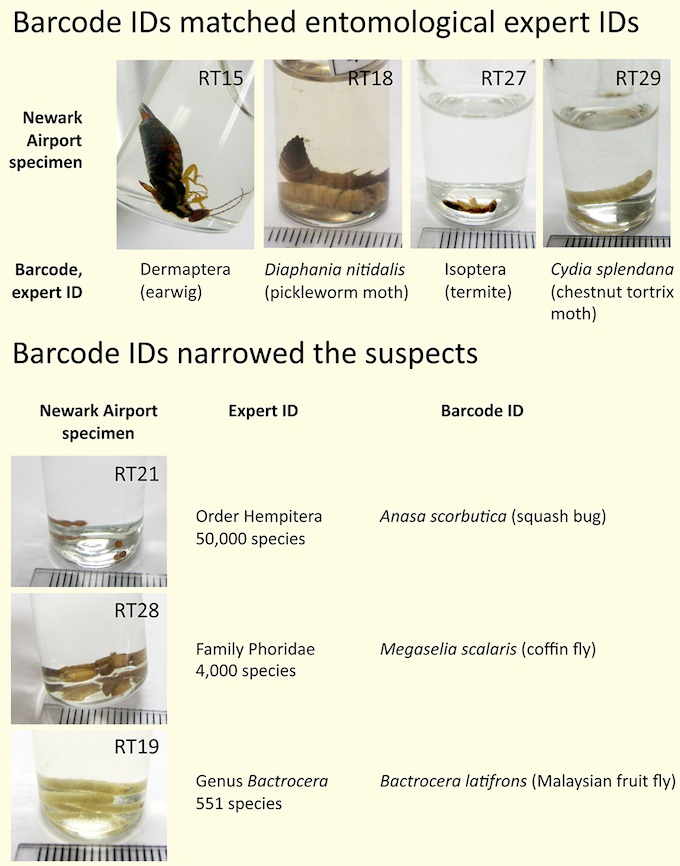ExoticBOL: Identifying Insect Pests at US Ports of Entry
Author: Robyn Tse, Massapequa High School
Mentor: Mark Stoeckle, Program for the Human Environment, Rockefeller University
Winner, Honorable Mention, Urban Barcode Project, June 2012
INTRO
Prompt recognition of agricultural pests is imperative to prevent economic and ecological damage
- U.S. Customs and Border Protection intercepts 40,000 to 50,000 agricultural pests yearly
- Morphological identification often slow and inexact
- 59% of urgent and 95% of non-urgent identifications require 2 or more days
- Many specimens identified only to order, family, or genus
HYPOTHESIS
DNA barcoding can supplement or substitute for entomological expertise in identifying insect pests
METHODS
- DNA extraction: Wizard Genomic DNA Purification Kit
- Amplification: Folmer primers with M13 tailsForward 5’-TGT AAA ACG ACG GCC AGT GGT CAA CAA ATC ATA AAG ATA TTG G-3’
Reverse: 5’-CAG GAA ACA GCT ATG AC TAA ACT TCA GGG TGA CCA AAA AAT CA-3’
35 cycles of 95°C for 30 s, 50°C for 30 s, and 72°C for 45 s - DNA barcode ID: ? 95% identity to reference sequence in GenBank or Barcode of Life Datasystems (BOLD)
RESULTS
- About 1/3 of specimens yielded DNA barcodes [10/32 (31%) yielded barcodes]
- Yield higher from immature vs adult specimens [7/9 immatures vs 3/23 adults (p=0.001)]
- Most gave barcode IDs [7/10 (70%) were ? 95% identical to a GenBank or BOLD reference sequence]
- Barcode IDs were the same or more detailed than morphologic IDs

CONCLUSION
DNA barcoding is a potential aid to rapid, accurate identification of insect pests at U.S. ports of entry
NEXT STEPS
- Improve barcode recovery (test alternate extraction methods, primers, storage conditions)
- Improve reference libraries (many pest species currently not represented)
HONORS
ExoticBOL was awarded Honorable Mention at the Urban Barcode Project (UBP) award ceremony held at American Museum of Natural History, June 2012 (ExoticBOL abstract, photos, and video presentation are posted on UBP site)
Images
Francis Krim Memorial
Inspection Station
ACKNOWLEDGMENTS
U.S. Customs and Border Protection, Newark International Airport
Frances Krim Memorial Inspection Station, APHIS, USDA
DNA Learning Center, Cold Spring Harbor Laboratories
Harlem DNA Laboratory
GenSpace
American Museum of Natural History
The Alfred P. Sloan Foundation

About the Bar Code of Life site
This web site is an outgrowth of
the Taxonomy, DNA, and Barcode of Life meeting held at Banbury
Center, Cold Spring Harbor Laboratory, September 9-12, 2003.
It is managed by Mark Stoeckle at the Program
for the Human Environment (PHE) at The Rockefeller University.
Contact: mark.stoeckle@rockefeller.edu
About the Program
for the Human Environment
The involvement of the Program for the Human Environment in DNA
barcoding dates to Jesse Ausubel's attendance in February 2002
at a conference in Nova Scotia organized by the Canadian Center
for Marine Biodiversity. At the conference, Paul Hebert
presented for the first time his concept of large-scale DNA
barcoding for species identification. Impressed by the
potential for this technology to address difficult challenges
in the Census of Marine Life, Jesse agreed with Paul on
encouraging a conference to explore the contribution
taxonomy and DNA could make to the Census as well as other large-scale
terrestrial efforts. In his capacity as a Program Director of
the Sloan Foundation, Jesse turned to the Banbury Conference
Center of Cold Spring Harbor Laboratory, whose leader Jan
Witkowski prepared a strong proposal to explore both the
scientific reliability of barcoding and the processes that
might bring it to broad application. Concurrently, PHE
researcher Mark Stoeckle began to work with the Hebert lab on
analytic studies of barcoding in birds. Our involvement in
barcoding now takes 3 forms: assisting the organizational
development of the Consortium for the Barcode of Life and the
Barcode of Life Initiative; contributing to the scientific
development of the field, especially by studies in birds, and
contributing to public understanding of the science and
technology of barcoding and its applications through improved
visualization techniques and preparation of brochures and other
broadly accessible means, including this website. While the
Sloan Foundation continues to support CBOL through a grant to
the Smithsonian Institution, it does not provide financial
support for barcoding research itself or support to the PHE for
its research in this field.
